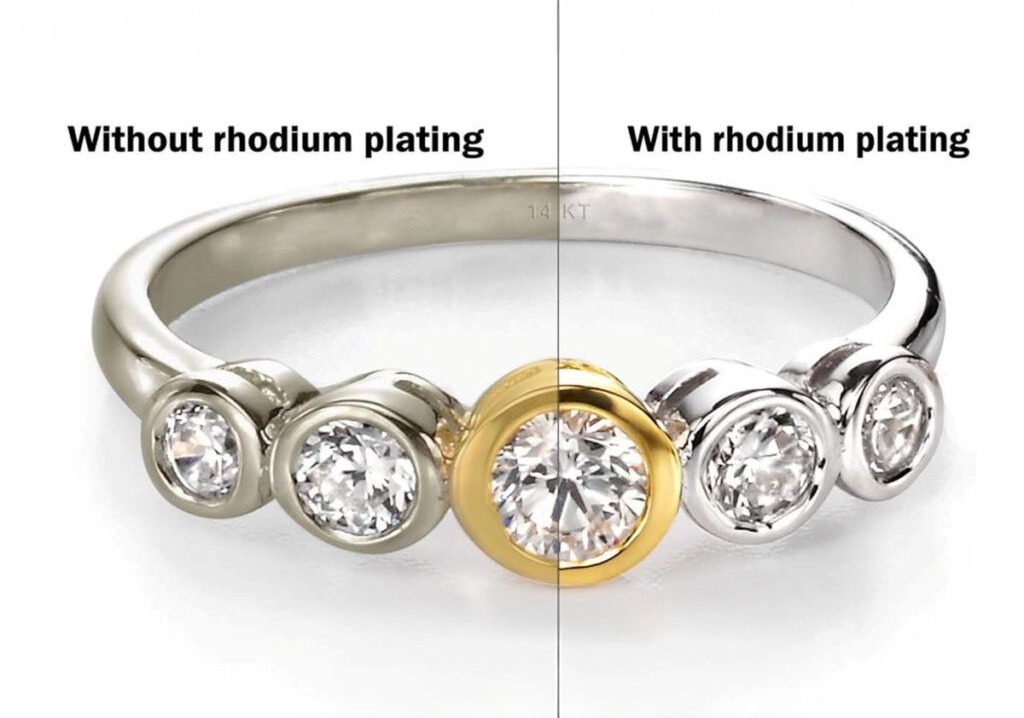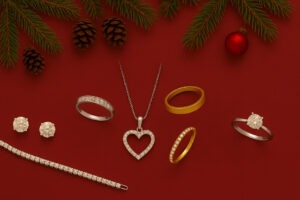Rhodium is a chemical element that has been assigned the symbol Rh. Its primary use is in catalytic converters for motor vehicles, but it also plays a crucial role in the jewelry industry. When a white gold jewelry piece is new, rhodium is electroplated onto the item to give it a bright white and reflective surface. In white gold, some of the alloys are nickel or palladium (both white metals), giving the gold a creamy white color.
In certain lighting, natural white gold can have a yellowish tint. However, when placed next to yellow gold, the white piece definitely appears white. The higher the gold content, the more yellow it will appear. Non-plated 18kt white gold will look more yellow than a 10kt white gold item. Rhodium finishes the process, and while it’s on the surface, it can make the karat of gold indistinguishable—they’ll all have a bright silver mirror finish!
Historical Background of Rhodium
Rhodium was discovered in 1803 by William Hyde Wollaston, an English chemist who also discovered palladium. Rhodium is one of the rarest and most valuable precious metals, and its unique properties quickly made it popular in various industries, including jewelry. Over the years, rhodium plating has become the standard for enhancing the appearance of white gold and providing a protective layer that keeps jewelry looking new.
The Rhodium Plating Process
The rhodium plating process involves cleaning the jewelry piece thoroughly to remove any oils or dirt. The piece is then submerged in a rhodium solution and subjected to an electric current that bonds the rhodium to the surface of the metal. This process not only enhances the appearance of the jewelry but also provides a protective layer that is resistant to tarnishing and scratching.
Benefits of Rhodium Plating
Rhodium is highly valued in the jewelry industry for its ability to enhance the appearance of white gold. It provides a bright, reflective finish that is both durable and hypoallergenic. Unlike other metals, rhodium is resistant to tarnish and corrosion, making it an ideal choice for jewelry that is worn daily. Additionally, rhodium plating can improve the jewelry’s durability, extending its lifespan.
Comparisons Between Plated and Non-Plated White Gold
The visual difference between rhodium-plated white gold and non-plated white gold is striking. Non-plated white gold has a warmer, yellowish tint, especially in higher-karat gold. On the other hand, Rhodium-plated white gold has a cool, bright white appearance that is often preferred for its modern, sleek look. The plating also adds a layer of protection, making the jewelry more resistant to wear and tear.
Customer Experiences
FAQs About Rhodium Plating
- How often does rhodium plating need to be reapplied? Rhodium plating typically needs to be reapplied every 12-18 months, depending on how often the jewelry is worn and how well it is cared for.
- Can rhodium plating be applied to other metals? Yes, rhodium plating can enhance the appearance and durability of various metals, including silver and platinum.
- What is the cost of rhodium plating? The cost varies depending on the size and type of the piece, but it is generally affordable and offers excellent value for the results.
Pure Rhodium Jewelry: A Rarity
Before and After
Care Instructions for Rhodium-Plated Jewelry

Industry Trends: Rhodium in Modern Jewelry
Environmental Impact of Rhodium Mining
Conclusion
References
New Age Metals Inc. “What is Rhodium and Why is it so Valuable?”
AU Precious Metals “What is Rhodium?”
Royal Society of Chemistry “Rhodium”




